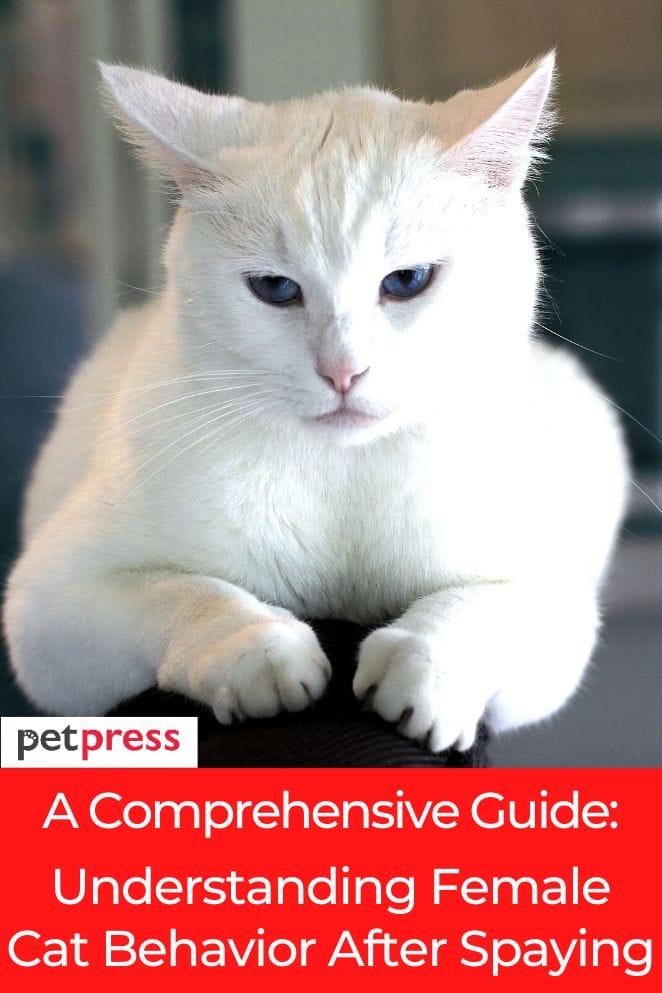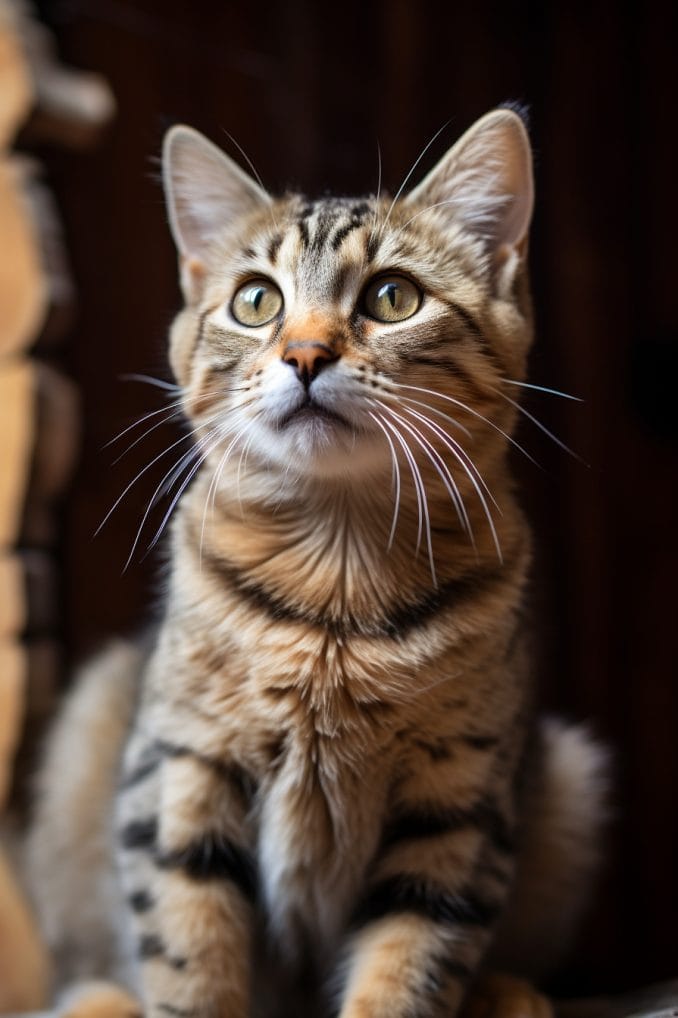
Welcoming a cat into your family brings joy and companionship, but responsible pet ownership also entails making choices for their overall well-being.
Among the critical decisions cat owners often confront is whether to spay their female feline companions.
In this article, we will explore the behavioral changes that may occur in your female cat after spaying, providing insights and tips to assist you in managing the post-surgery period effectively.
Behavioral Post-Spaying Period
Spaying, a routine surgical procedure involving the removal of a female cat’s reproductive organs, serves as a preventive measure against unwanted pregnancies and often triggers behavioral changes in your furry companion.
Immediately after surgery
Following the spaying procedure, your cat may display grogginess and disorientation, typical side effects of anesthesia.
To aid her recovery, provide a calm and comfortable space.
Create a quiet area where she can rest undisturbed, allowing her to gradually regain her senses in a stress-free environment.
Within the first few days
In the first few days post-surgery, you may observe a temporary decrease in your cat’s energy levels and appetite.
This is a natural aspect of the recovery process and shouldn’t cause alarm.
Paying close attention to her well-being during this period is crucial.
Offer small, easily digestible meals to support her recovery, and ensure she always has access to fresh water to stay adequately hydrated.
After the first week
As your cat progresses through the first-week post-surgery, you may witness positive signs of her returning to her usual self.
It’s important to recognize that each cat heals at its unique pace.
Some may recover quickly, while others may take more time.
Patience is crucial during this phase, so continue providing the necessary care and attention to support her complete recuperation.

Changes in Behavior in Spayed Female Cats
Spaying can bring about positive behavioral changes in female cats. These include:
Increased relaxation
After the spaying procedure, your female cat is likely to experience increased relaxation.
The absence of hormonal fluctuations, especially those associated with the reproductive cycle, contributes to a more serene and composed demeanor.
This newfound tranquility is a positive aspect of the post-surgery period.
Decreased mating-related behaviors
One notable change you may observe is a reduction in certain mating-related behaviors.
Spaying eliminates the influence of reproductive hormones, leading to a decrease in behaviors such as yowling, restlessness, and marking territory.
Your cat’s overall disposition may become more stable and predictable.
Diminished aggressive tendencies
Hormonal changes can often contribute to aggressive tendencies in unspayed female cats.
After spaying, you may notice a decrease in aggressive behaviors.
This positive shift can create a safer and more harmonious environment for both your cat and those around her.
Increased affection
Another noteworthy change is the potential increase in affectionate behavior.
With hormonal influences minimized, your cat may become more inclined to seek out and enjoy positive interactions.
This could include an increase in cuddling, purring, and other signs of affection, strengthening the bond between you and your feline companion.
Enhanced sociability
Spaying can also lead to increased sociability in female cats.
Reduced hormonal fluctuations often result in a more sociable and amiable temperament.
Your cat may be more open to interacting with other pets, family members, and even guests, fostering a more inclusive and enjoyable social environment.

Common Side Effects
While spaying is generally a safe procedure, some common side effects may occur during the recovery period. These can include:
- Mild swelling: After the spaying procedure, it’s not uncommon for there to be some mild swelling around the surgical site.
- Redness: Redness is a natural inflammatory response to surgery and is generally part of the healing process.
- Bruising: Bruising may also occur, manifesting as discolored areas around the surgical site. Like swelling and redness, bruising is usually temporary.
- Temporary changes in litter box habits: Some cats may exhibit temporary changes in litter box habits after spaying. This can include alterations in the frequency of urination or defecation.
- Unusual symptoms: Keep an eye out for any unusual or persistent symptoms that go beyond the expected post-surgery effects. This may include excessive lethargy, refusal to eat, or signs of discomfort.
Tips for Caring for Your Spayed Cat
Provide a comfortable recovery space
Establish a dedicated and quiet recovery space for your spayed cat.
Set up a cozy area with soft bedding where she can retreat to rest undisturbed.
Minimize noise and disruptions to create a stress-free environment conducive to healing.
Monitor her closely
Keep a close watch on your cat’s behavior during the recovery period.
Observe any changes in her activity levels, demeanor, and interactions.
Pay attention to eating habits and monitor her litter box use.
Early detection of any unusual behavior allows for timely intervention if needed.
Administer medications as prescribed
If your veterinarian prescribes post-surgery medications, ensure you understand the dosage and administration instructions.
Administer medications as directed, and if you have any concerns or questions about the medications, consult with your veterinarian promptly.
Gradual return to normal activities
While it’s essential to provide a quiet recovery space, encourage a gradual return to normal activities.
However, avoid strenuous play or jumping during the initial days post-surgery.
Allow your cat to set the pace for resuming regular behaviors, promoting a smooth transition back to her usual routine.
Maintain a balanced diet
Ensure your spayed cat receives a nutritious and well-balanced diet.
Proper nutrition plays a crucial role in supporting her overall health and aiding in the recovery process.
Consult with your veterinarian to determine any specific dietary recommendations or adjustments that may be beneficial during this period.
Hydration is key
Monitor your cat’s water intake to ensure she stays well-hydrated.
Adequate hydration supports the healing process and helps prevent complications.
Provide access to fresh water at all times, and if you notice any signs of dehydration, such as reduced water consumption, consult with your veterinarian.

Gentle interaction and comfort
Offer gentle and comforting interactions with your cat. Spend quality time together without overwhelming her.
Positive attention and reassurance contribute to her emotional well-being during the recovery phase.
Follow-up veterinary visits
Schedule and attend any follow-up veterinary visits as recommended.
These appointments allow your veterinarian to assess your cat’s progress, address any concerns, and make necessary adjustments to the post-surgery care plan.
Conclusion
Opting for spaying is a responsible choice that not only promotes the overall well-being of your female cat but also plays a vital role in managing the feline population.
Acquiring insights into the potential behavioral changes following the procedure equips you to offer the necessary care and assistance throughout the recovery phase.
By staying attuned to your cat’s requirements and implementing the provided tips, you can ensure a seamless and positive post-spaying experience for your feline companion.
FAQs
Yes, spaying is a routine procedure performed by veterinarians and is generally considered safe. However, like any surgery, there are risks involved. Your veterinarian can provide more information based on your cat’s individual health.
The recovery period varies from cat to cat. While some may bounce back within a week, others may take a bit longer. It’s essential to be patient and provide the necessary care during this time.
Yes, spaying has long-term health benefits, including a reduced risk of certain reproductive-related illnesses and the prevention of unwanted pregnancies.
While it’s possible to spay a cat after she has had a litter, it’s generally recommended to spay before the first heat cycle to maximize the health benefits and prevent further pregnancies. Consult with your veterinarian for personalized advice.


GIPHY App Key not set. Please check settings